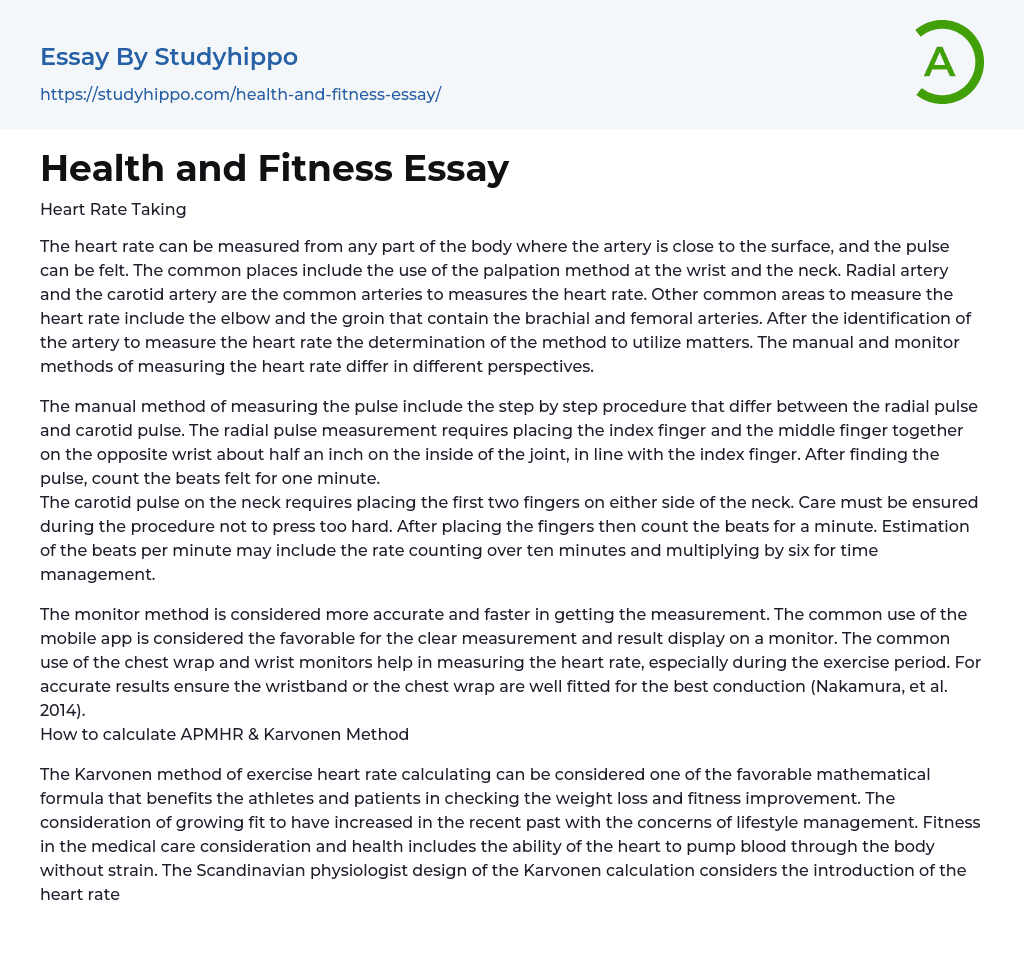Heart Rate Measurement
The heart rate can be measured by feeling the pulse in any area where the artery is near the surface of the body. Common locations for taking the pulse include the wrist and the neck.
Radial artery and carotid artery are commonly used arteries to measure the heart rate, along with the brachial and femoral arteries found in the elbow and groin. Once the artery is identified, the method for measuring the heart rate must be determined. The manual and monitor methods of measuring the heart rate have contrasting procedures for both radial and carotid pulses.
To measure the radial pulse, gently place the index finger and middle finger together on the opposite wrist approximately half an inch inward from the joint, aligning with the index finger. Once the pulse is
...located, count the number of beats felt for one minute. For measuring the carotid pulse located on the neck, place the first two fingers on either side of the neck. Be cautious not to apply excessive pressure. Once the fingers are properly positioned, count the number of beats for one minute.
The estimation of beats per minute (BPM) can be done by counting the rate over a duration of ten minutes and then multiplying by six to manage time. The monitor method is considered to be more accurate and quicker in obtaining measurements. The use of a mobile app is commonly preferred as it provides clear measurements and results displayed on a monitor. Both chest wrap and wrist monitors are commonly used to measure heart rate, particularly during exercise. To ensure accurate results, it is important to properly fit th
wristband or chest wrap for optimal conduction (Nakamura, et al., 2014).
The Karvonen method, a mathematical formula, is advantageous for athletes and patients in assessing weight loss and fitness improvement. The importance of maintaining good health and fitness has increased due to lifestyle management concerns. In medical care, fitness involves the heart's ability to pump blood without strain. The Karvonen calculation, developed by a Scandinavian physiologist, incorporates the heart rate reserve, which is the difference between the maximum heart rate and resting heart rate. To determine a target heart rate for patients or athletes, the Karvonen formula uses the resting and maximum heart rates along with training intensity. However, it is crucial for the maximum and resting heart rates to be accurately measured for precise calculation using the formula.
The formula for estimating the maximum heart rate is (208 - 0.7 x age). The heart rate reserve, on the other hand, calculates the difference between the maximum and resting heart rates. The formula for determining the target heart rate is as follows: Target Heart Rate = ((max HR ? resting HR) ? %Intensity) + resting HR.
How to Take a Blood Pressure
The measurement of blood pressure requires the use of a blood pressure kit, especially at home, for a simplified measurement procedure. Common tools available at pharmacies and medical supply stores include cuffs and digital electronic technology.
The body's condition can be determined by blood pressure, which can indicate symptoms of organ failure leading to stroke and heart failure (Nakamura, et al.2014). The measurement of blood pressure using a cuff simulator involves the following steps:
- Inflate the simulator multiple times using the 'Inflate Cuff' button.
- Deflate
the simulator using the 'Open Valve' settings before closing the valve.
The Use of Submaximal Graded Exercise Test Protocol
The submaximal exercise protocol is a physical activity protocol that gradually increases intensity up to but not exceeding 85% of maximum heart rate. Comparing submaximal exercise testing and maximal exercise testing is particularly useful for physical therapists in their role as clinical exercise specialists. The protocol involves using performance and predictive tests to measure relative merits. The predictive test estimates maximal aerobic capacity, while the performance test measures the response to standardized physical activities commonly encountered in daily life (Noonan, Dean, 2000). For submaximal graded exercise testing, equipment like bikes or treadmills are typically used in the measurement process.
The test styles are designed in the manner in which to measure the fitness with minimal variations between manufacturers. The typical grading of the fitness test includes weight, height, blood pressure, and heart rate measurements. The training begins with low intensity under the guidance of a trained professional and gradually increases with the adoption of speed and energy (Noonan, ; Dean, 2000). The submaximal graded fitness test ends when the heart reaches 85% of the maximum heart rate.
References
- Noonan, V., ; Dean, E. (2000). Submaximal Exercise Testing: Clinical Application and Interpretation. Physical Therapy, 80(8), 782-807. Accessed September 02, 2016. Retrieved from http://ptjournal.apta.org/content/80/8/782.
- Nakamura, H., She, J., Makino, K., Ohyama, Y., ; Hashimoto, H. (2014).
The International Journal of Automation and Computing (11(1), 56-61) presents a study on comparing and selecting formulas for maximum heart rate in
relation to the Karvonen formula used in pedaling exercise.
- American Football essays
- Athletes essays
- Athletic Shoe essays
- badminton essays
- Baseball essays
- Basketball essays
- Benefits of Exercise essays
- Bodybuilding essays
- Boxing essays
- cricket essays
- Fight club essays
- Football essays
- go kart essays
- Golf essays
- Gym essays
- hockey essays
- Martial Arts essays
- Motorcycle essays
- Olympic Games essays
- Running essays
- scuba diving essays
- Ski essays
- snowboarding essays
- Soccer essays
- Sportsmanship essays
- Super Bowl essays
- Surfing essays
- Swimming essays
- Table tennis essays
- Taekwondo essays
- Tennis essays
- Training essays
- Volleyball essays
- wrestling essays
- Yoga essays
- Activity essays
- Believe essays
- Comfort Zone essays
- Dance essays
- Fashion essays
- Fishing essays
- Fitness essays
- Freedom essays
- Habits essays
- Healthy Lifestyle essays
- Hobby essays
- Hunting essays
- Interests essays
- Justification essays
- Moment essays




